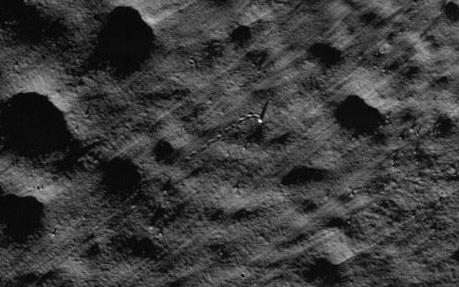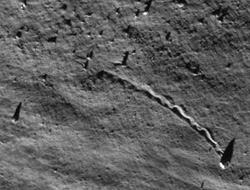It’s been a while since I’ve posted a cool close-up picture of the Moon from the Lunar Reconnaissance Orbiter (or LRO), and this one is too nifty not to share:

Photo by NASA/GSFC/Arizona State University
What you’re looking at is a region about a kilometer (0.6 miles) across not far from an impact crater—the actual crater is off the frame, below and to the left. Probably a billion years ago or so, something the size of a house slammed into the Moon, carving out a crater a few hundred meters across.
When it did, several hundred thousand tons of lunar surface were blasted out of the hole. Erupting into the sky, it spread out in all directions, including straight up, forming a huge plume. This superheated material expanded outward, blowing like a wind on the airless surface. When the dust literally settled, it formed hundreds of linear striations, all pointing back to the crater. And now, today, we see an echo of that event, strewn across the surface.
This crater is located pretty far north, so the Sun is low to the horizon. That makes long shadows, and accentuates the topography of the local terrain. You can really see all the bumps and wiggles of the surface, and those long narrow fingers are obvious.
This image is one part of a much longer stripe of lunar surface seen by LRO. While I was perusing it, I actually smiled in delight when I zoomed in and saw this:

Photo by NASA/GSFC/Arizona State University
That white spot is a boulder a few meters in size. You can see its shadow going off to the upper right. But do you see that curved dotted line, a J-shape that ends at the boulder? That’s its track in the surface! The boulder looks like it rolled, moving from the lower left to the upper right, and then took a right-handed hook before coming to rest. If you look carefully, you’ll see that just before it stopped rolling it was on the upper left edge of a small depression, and then rolled into it. The dashed pattern in the track is probably due to irregularities in the shape of the rock as it rolled.

Photo by NASA/GSFC/Arizona State University
I love pictures like this! It shows the imprint (literally) of motion, in a landscape that appears forever frozen in time. Inset here is another such image from a bigger rock, where the track and shadows from other rocks are easier to see as well. The path of the rock gently curves as it follows the local curve of the ground.
All of these scenes can be found in the high-res image from LRO, and I invite you to take a look for yourself and see what you can discover. It’s amazing to think that we can sit in the luxury of our home environment here on Earth, and peruse pictures of the Moon taken by a probe that’s been orbiting our nearest neighbor for the past four years now, pictures which have a resolution of one meter per pixel.
We already live in the future, and it’s brought to you by SCIENCE.